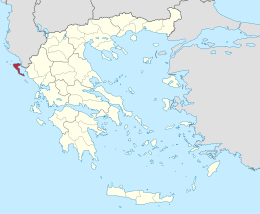
Back Corfu Afrikaans كورفو Arabic Corfú AST Kerkira Azerbaijani Керкіра Byelorussian Керкіра BE-X-OLD Корфу Bulgarian Korfou Breton Corfú Catalan Corfu (pulo) CEB
Native name: Κέρκυρα Nickname: Το νησί των Φαιάκων (The island of Faiakes) | |
|---|---|
 | |
 | |
| Geography | |
| Coordinates | 39°36′N 19°52′E / 39.60°N 19.87°E |
| Area | 610.9 km2 (235.9 sq mi) |
| Highest elevation | 906 m (2972 ft) |
| Administration | |
| Administrative region | Ionian Islands |
| Regional unit | Corfu |
| Capital city | Corfu |
| Demographics | |
| Demonym | Corfiot, Corfiote |
| Population | 99,134 (2021) |
| Pop. density | 163.44/km2 (423.31/sq mi) |
| Additional information | |
| Time zone | |
| • Summer (DST) | |
| Postal code | 490 81, 490 82, 490 83, 490 84, 491 31, 491 32 (former 491 00) |
| Area code(s) | 26610, 26620, 26630 |
| Official website | www |
Corfu (/kɔːrˈf(j)uː/ kor-FEW, -FOO, US also /ˈkɔːrf(j)uː/ KOR-few, -foo) or Kerkyra (Greek: Κέρκυρα, romanized: Kérkyra, pronounced [ˈcercira] ⓘ)[a] is a Greek island in the Ionian Sea, of the Ionian Islands,[1] and, including its small satellite islands, forms the margin of the northwestern frontier of Greece.[2] The island is part of the Corfu regional unit, and is administered by three municipalities with the islands of Othonoi, Ereikoussa, and Mathraki.[3] The principal city of the island (pop. 32,095) is also named Corfu.[4] Corfu is home to the Ionian University.
The island is bound up with the history of Greece from the beginnings of Greek mythology, and is marked by numerous battles and conquests. Ancient Korkyra took part in the Battle of Sybota which was a catalyst for the Peloponnesian War, and, according to Thucydides, the largest naval battle between Greek city states until that time. Thucydides also reports that Korkyra was one of the three great naval powers of fifth century BC Greece, along with Athens and Corinth.[5] Ruins of ancient Greek temples and other archaeological sites of the ancient city of Korkyra are located in Palaiopolis. Medieval castles punctuating strategic locations across the island are a legacy of struggles in the Middle Ages against invasions by pirates and the Ottomans. Two of these castles enclose its capital, which is the only city in Greece to be surrounded in such a way. As a result, Corfu's capital has been officially declared a Kastropolis ("castle city") by the Greek government.[6] From medieval times and into the 17th century, the island, as part of the Republic of Venice since 1204, successfully repulsed the Ottomans during several sieges, was recognised as a bulwark of the European States against the Ottoman Empire and became one of the most fortified places in Europe.[7] The fortifications of the island were used by the Venetians to defend against Ottoman intrusion into the Adriatic. In November 1815 Corfu came under British rule following the Napoleonic Wars, and in 1864 was ceded to modern Greece by the British government along with the remaining islands of the United States of the Ionian Islands under the Treaty of London. Corfu is the origin of the Ionian Academy, the first university of the modern Greek state, and the Nobile Teatro di San Giacomo di Corfù, the first Greek theatre and opera house of modern Greece. The first governor of independent Greece after the revolution of 1821, founder of the modern Greek state, and distinguished European diplomat Ioannis Kapodistrias was born in Corfu.
In 2007, the city's old town was added to the UNESCO World Heritage List, following a recommendation by ICOMOS.[8][9][10] The 1994 European Union summit was held in Corfu.[11] The island is a popular tourist destination.[12][13]
Cite error: There are <ref group=lower-alpha> tags or {{efn}} templates on this page, but the references will not show without a {{reflist|group=lower-alpha}} template or {{notelist}} template (see the help page).
- ^ Cite error: The named reference
Independentwas invoked but never defined (see the help page). - ^ Trevor Webster (1994). Where to Go in Greece: A New Look. Vol. 1. Settle Press. p. 221. ISBN 9781872876207.
Corfu is one of the most northern isles in Greece and also the most westerly, apart from three of its own small satellite isles...
- ^ https://corfutvnews.gr/diaspasi-deite-tin-tropologia/ (in Greek)
- ^ "ΦΕΚ B 1292/2010, Kallikratis reform municipalities" (in Greek). Government Gazette.
- ^ Thucydides, History of the Peloponnesian War 1.36.3
- ^ "Corfu City Hall website". City of Corfu. Archived from the original on 6 January 2008.
In literature, apart from the Homeric name Scheria, we meet various other names for the island, like Drepanë or Arpi, Makris, Cassopaea, Argos, Keravnia, Phaeacia, Corkyra or Kerkyra (in Doric), Gorgo or Gorgyra and much later the medieval names Corypho or Corfoi, because of the two characteristic rock-peaks of the Old Fortress of Corfu.
- ^ Johann Georg Keyssler (1760). Travels Through Germany, Bohemia, Hungary, Switzerland, Italy, and Lorrain: Giving a True and Just Description of the Present State of Those Countries …. G. Keith. p. 54. Retrieved 6 July 2013.
Corfu is not only a bulwark to the Venetians against the attack of a foreign enemy,... [...] ....and, since count Schulenburg caused several fortifications to be added to it, it may justly be looked upon as one of the strongest places in Europe.
- ^ "on UNESCO World Heritage List". BBC News. 28 June 2007. Retrieved 29 June 2009.
- ^ "UNESCO Advisory Body ICOMOS report on Corfu History" (PDF). Retrieved 3 July 2007.
- ^ "Old Town of Corfu on UNESCO website retrieved 3 July 2007". Whc.unesco.org. Retrieved 29 June 2009.
- ^ ANDREW MARSHALL IN CORFU (24 June 1994). "European Union Summit: Corfu summiteers ready to fudge key EU decision". The Independent.
- ^ Duncan Garwood, Mediterranean Europe, 2009
- ^ Russell King, John Connell, Small worlds, global lives: islands and migration, 1999
© MMXXIII Rich X Search. We shall prevail. All rights reserved. Rich X Search